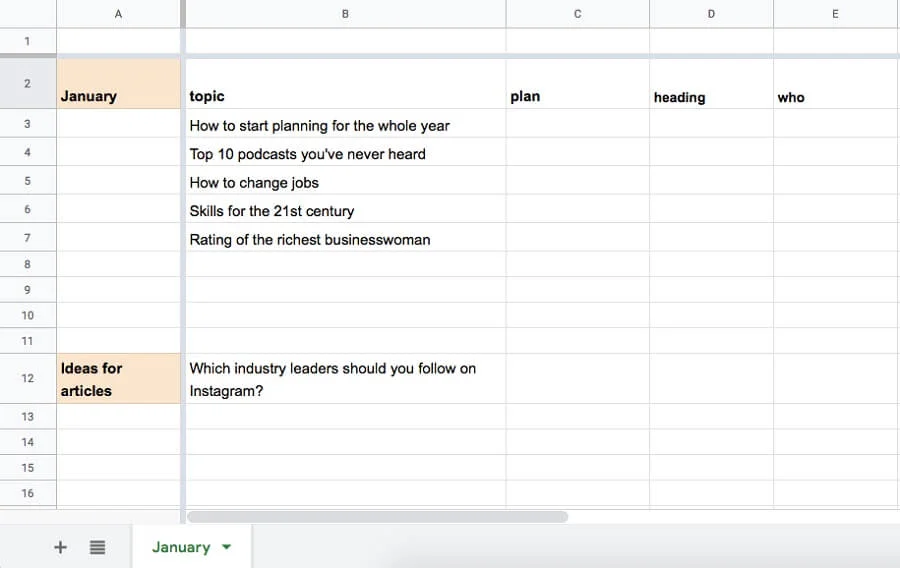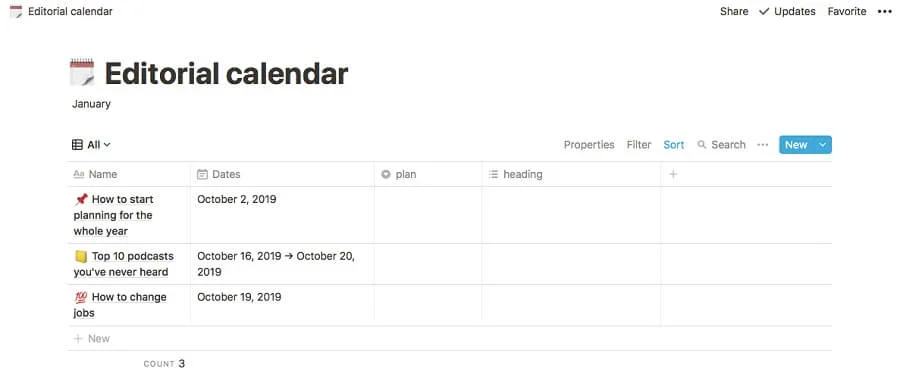An editorial calendar often begins with an ambitious idea to structure all work and ends in less than a content plan. When working with these tools, it is vital to be clear about your goals and gradually build up processes within the team based on them.
It will make your life all-around easier and let you plan your releases smartly and release posts, articles, stories, and other content without cramming to deadlines and force majeure in chat rooms. That way, you will be able to focus on texts that interest the audience you are working with and attract more of them with advertising and organic reach.
In this article, we will discuss the differences between an editorial calendar and a content plan — how to start and what a calendar can give editorial teams, bloggers, and content marketing companies. We will learn what services for creating editorial calendars are the most convenient.

The editorial calendar: the difference
A content plan is for planning and releasing content for the coming week. It usually takes the form of an Excel spreadsheet with release dates and specific ideas of posts, stories, live streams, Reels, categories, headers, images, statistics, and everything else for scheduled releases.
If you use platforms that allow you to work with social media, you can create a content plan directly in your profile. Onlypult has a standard social network control panel, where you can manage several accounts side by side. Schedule releases and see if anything is missing in every audience communication channel.
An editorial calendar, on the other hand, covers releases over the length of a month, quarter, or year. Editorial teams, companies with corporate blogs, and bloggers who prepare to roll out advertising materials can all use one.
Preparing an editorial calendar
As far as form is concerned, it should be something convenient for all members of the team and suitable for all content formats you work with. Keep resizing in mind and adapt the same content to different social networks and platforms.
There can be different formats for a guest podcast: video for IGTV, a text-only interview, or a blog article. Or it can be 2-3 posts of various types (news highlight, expert opinion, discussion post) and email newsletters, also different for each segment. And you can adapt any post for each social network and make a unique text for each link to the podcast.
For long-term planning, an editorial calendar is a way to think through all aspects of content production. You can plan to make a few exclusive Instagram videos with a guest or conduct the conversation in a way that gives you a maximum of content you will be able to reuse.

What goes into an editorial calendar
- ideas from your team members;
- newsworthy events;
- PR events;
- anniversaries important for the brand;
- always relevant topics.
Ideas from your team members
Even small brands suffer from a lack of communication between different levels of the organization. The most common example: a blogger put up advertising without warning the technical staff, new requests inundated the site, and it crashed.
With synergy, on the other hand, an editorial calendar will be continuously filled with posts and articles relevant for potential or future clients. That is why it is so vital to write down all of your personnel’s suggestions in the planning briefs.
Example. Managers of an online fitness school complain that customers cannot tell the difference between offered programs. And each time those managers have to send them additional accompanying material.
For this kind of situation, you need to create a “What to do if” category in the calendar and adjust it to every season, segment of the target audience, and new program. That could be a “Best young mom fitness course”, “Perfect summer workouts” or “Getting in shape for end-of-year holidays” quiz.
Newsworthy events
It is crucial for editorial teams and media. If there is a subject worth returning to in a year with an update or a review, it can be added to the calendar.
News is often clearly related to the brand subject or style, but the variety is good here, as well. Brands can, for example, show attention to other people’s content and make a statement about a popular YouTube video.
Example. The clothes manufacturing company talks about its Spring-Summer collection ten years back and what has changed since then. This kind of news can definitely be prepared for in an editorial calendar.
It may even prompt the introduction of a permanent section featuring interviews with brand designers and fashion history videos that explain what creates trends and how fashion ideas change over time.
PR events
Here you would schedule all collaborations and core events for the coming year. They will need a separate media space promotion plan, support of bloggers, news sources, and influencers.
Add planned charity events; this is a separate field where the audience needs to be primed and prepared. You can also come up with interesting promotions or hashtags to attract users and get more attention with UGC.
Example. Zewa declares war on housework inequality. A campaign under the hashtag #GoodHouseFairHouse calls for the genders to split their chores fairly. That social experiment was referred to thousands of times in the media, blogs, and social network user content. Most importantly, the brand was able to proclaim its values.
Anniversaries
An obvious part of a plan, but not everyone uses a calendar for it. Not just well-known and popular holidays should be celebrated – use every little excuse.
Well-timed releases can give an entertaining spin to relevant content, draw attention to marketing material and conceal its nature.
Example. Some clear choices: a selection of dairy myths from a dairy manufacturer for the World Milk Day, June 1st; an eco-brand that makes reusable drinking straws calls to reduce plastic use on the World Environment Day, June 5th.
A less frequent case: a travel agency releases an animated video following Leopold Bloom from Joyce’s “Ulysses” through Dublin in the footsteps, for Bloomsday, celebrated every year by fans of the writer.
Always-relevant topics
All bloggers, brands, and media have their hobby horses, rocking on which they always get some traffic. It is difficult to predict what exactly will be published in a year or several, but keeping abreast of the subject makes sense.
The best way to follow up on who said what about it is to set up an RSS feed with all trusted sources or look at government websites. Sometimes talk shows can be informative, too: Oprah Winfrey’s interviews result in an avalanche of celebrity news every time.
Example. A business blogger could set up a feed to draw on the news about investments, legislative changes, business people’s forecasts about their field, especially relevant in a crisis. Mass media are a good source for this — use push notifications.
Make special slots in the editorial calendar for these kinds of instant themes. And you will always have plans to publish something relevant to the day.
Where to keep an editorial calendar
Use any service well-suited to your purposes and comfortable to use.
The calendar is a table for your subjects of interest, ideas, deadlines, and responsible personnel. Taking it a step further, you can add reviews of content: which materials have gone viral, brought better feedback, or sales.
Here are examples of simple editorial calendars in three well-known services.
Google Tables

Notion

Asana

Advantages of an editorial calendar
You have to work really hard to separate and streamline the processes in your team for a calendar to work, but the pros outweigh this con.
Variety of content
A calendar encourages creativity. It is an invitation to leaf back and forth through a library of materials. And any member of the team can dig down to past releases and suggest something of their own.
Tracking successes
All the information about posting dates and materials with the most feedback (reposts, comments, reactions, media mentions) is in the calendar.
SEO improvement
When planning with an editorial calendar, it makes sense to write keywords and phrases to get a ready keyword list for search engines for future publications. That is practical for corporate blogs.
Source of original ideas to include
When the whole field of work is clearly visible, it is easier to look for imaginative solutions, and creativity can flow. No one will be stressing you about deadlines you have forgotten because releases will all be timed. And you will be able to see which formats are overused and whether you need to try something new.
Content management in one place
An editorial calendar is like Alfred the butler for Batman: it not only helps out but provides a firm direction at difficult moments. When something in the materials is not ready, you can always pull the blanket in a different direction.
Conclusions:
- An editorial calendar lets you get more done. You can react to popular topics on time and lead in your field, publish heldful content for the target audience without hurry, prepared well in advance of clear deadlines by your team.
- More straightforward content production. You can have it all planned: an editorial calendar to be created, topics to migrate to the content plan little by little, to be worked over by the writers, SMM specialists, line editors, and the rest of the creative staff.
- A complete thematic roadmap. Here you can enter input from the team, news and PR events, relevant anniversaries, and always vital topics.
- Editorial calendar services: Google-sheets, Notion, Trello, Asana. Whichever you choose, you need to have user-friendly work algorithms in place for the team, and all team members must have access.
- Brings content marketing to a new level. You can find original ideas for content, optimize content for SEO, keep formats diverse and watch content statistics in the same place.






